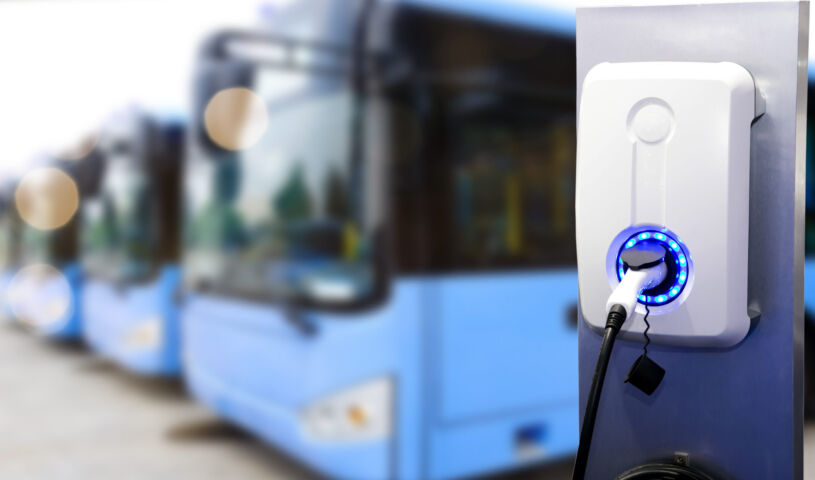Municipalities switch to electric buses to cut emissions
 Municipal leaders say that local governments have a crucial role to play in reducing emissions, and tackling transportation emissions is a key part of that effort. Photo: Adobe Stock
Municipal leaders say that local governments have a crucial role to play in reducing emissions, and tackling transportation emissions is a key part of that effort. Photo: Adobe Stock
Municipalities big and small across Canada have set themselves targets for reducing emissions and reaching net-zero. According to Statistics Canada, the transportation sector is the country’s second largest source of greenhouse gases, making up around 22 per cent of emissions. Data also shows that between 1990 and 2021, the sector’s emissions increased by 27 per cent.
Those figures indicate that reducing transport emissions will be a key part of meeting Canada’s reduction targets.
Municipal leaders say that local governments have a crucial role to play in reducing emissions, and tackling transportation emissions is a key part of that effort.
“Climate action can’t work without local communities fully onboard,” said Federation of Canadian Municipalities (FCM) President Scott Pearce. “Transit and transportation are also a big part of the answer to reach Canada’s net-zero by 2050.”
Pluses of Electric Buses
Experts say making the switch to electric buses can help them meet those targets.
In December 2022, researchers at Concordia University published a study on ways to analyze the effectiveness of electrification. In the study, titled: Achieving urban net-zero targets through regionalized electric bus penetration and energy transition, they found electrifying bus fleets could significantly reduce emissions and well as maintenance and health-related costs.
“When combined with other efforts to decarbonize energy systems, our research shows that from 2019 to 2030, cumulative GHG emissions of bus fleets in Toronto, Montreal, Edmonton and Halifax were reduced by 18.7 per cent, 30.1 per cent, 21.3 per cent and 34.6 per cent respectively,” said Xuelin Tian, a PhD student at Concordia’s Department of Building, Civil and Environmental Engineering and the study’s lead author.
“Transit electrification has emerged as a potential solution for enhancing the sustainability of road transportation,” the study stated.
E-buses in Canada
Electric buses aren’t new to Canada, and some municipalities have been using them for decades. Last year, Vancouver marked 75 years of its trolley bus routes. There were 30 buses when they were rolled out in 1948, today the number is 262.
Last year, TransLink, the authority that manages public transit in Metro Vancouver, announced it would be adding 15 more electric buses to its fleet. The authority says the new buses will be able to travel 150 kilometres on a single charge and reduce emissions by over 1,000 tonnes a year once they’re all in operation.
“Electrifying our bus fleet and moving to renewable fuels are the fastest ways TransLink can reduce GHG emissions to help combat climate change,” said TransLink CEO Kevin Quinn. “Taking transit is already one of the best ways people can reduce their carbon footprint, but through electrification and the actions outlined in our Climate Action Strategy, we’re working to reduce our impact on the climate to zero.”
The push for electrification isn’t only focused on transit buses. A November report from the Canadian Electric School Bus Alliance (CESBA) called for Canada to accelerate the adoption of electric school buses (ESBs). The report states that making a complete switch to ESBs would potentially “remove 1.17 million tonnes of GHG emissions annually, the equivalent of avoiding 1.66 million one-way flights from Halifax to Vancouver every year.”
CESBA’s goal is for all school buses across Canada to be electric by 2040. That goal is ambitious. According to the alliance, only two per cent of Canada’s estimated 51,000 school buses are electric.
P.E.I is currently the province with the most ESBs, with more than a quarter of its fleet electrified. The province has set a target for a fully electrified fleet of school buses by the end of this decade. Quebec has mandated that all new school buses should be electric, with a goal of 65 per cent being so by 2030.
Challenges to Electrification
Despite ambitious targets, there have some stumbling blocks along the way to electrification. In St. Albert, Alta. officials in the city just outside Edmonton recently found that the seven electric buses they bought weren’t lasting as long as they were expected to.
Initially, it was though the buses’ batteries would last around 18 years. Premature degradation and other mechanical issues, however, mean they are likely to last closer to 12 years. City spokesperson Pamela Osborne said that three of the buses already needed to have their batteries replaced.
Over in Edmonton, the city has been dealing with a similar issue. When new electric buses were added in 2020, Edmonton’s then mayor, Don Iveson, said they were “particularly efficient financially.”
But by last November, more than half of the city’s electric buses needed spare parts and most weren’t fit to be on the road. Those issues were compounded when the manufacturer, California-based Proterra, filed for bankruptcy.
“EV buses are a huge investment, so obviously money is a challenge to transitioning to all-electric fleets,” Tian said.
These kinds of issues can make local and provincial governments cautious about switching to electric buses. In St. Albert, the buses cost around $970,000 each, with most of the funding coming from the province. MW
✯ Municipal World Executive and Essentials Plus Members: You might also be interested in Daair’s article: Victoria leading the way to an electric future.
Ibrahim Daair is Staff Writer at Municipal World.
Related resource materials:



